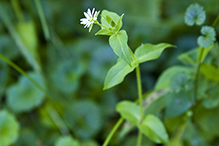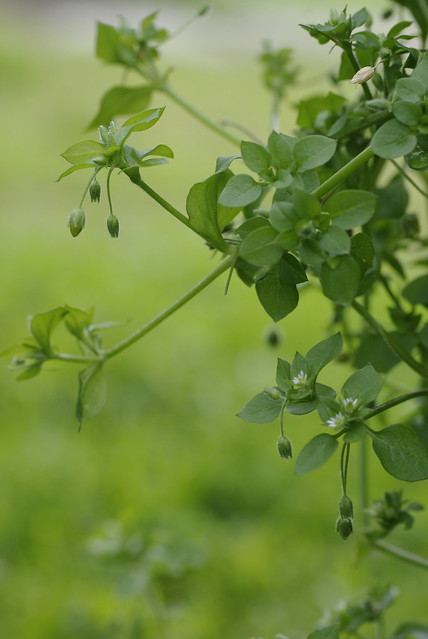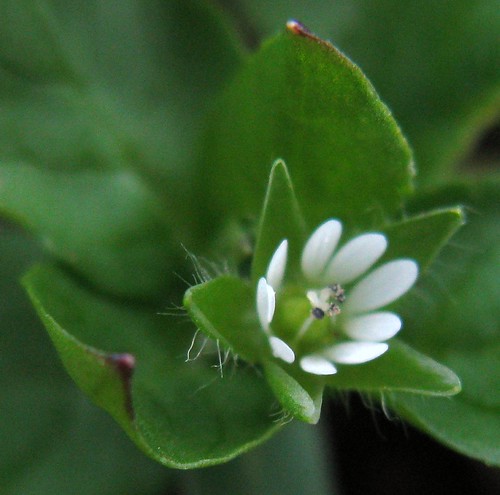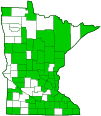common chickweed
(Stellaria media)
Conservation • Wetland • Description • Habitat • Ecology • Use • Distribution • Taxonomy
Description |
||
Common chickweed is a 2″ to 16″ tall, annual or short-lived perennial forb that rises from a slender taproot. The stems are sometimes ascending but more commonly the lower portion of the stem reclines on the ground (decumbent) while the upper portion is erect or ascending. They are 4″ to 32″ long but only 2″ to 16″ due to their decumbent form. They are green or burgundy, 4-sided, abundantly branched below the middle, and hairless except for a single line of hairs on one side between the nodes. The leaves are opposite, egg-shaped to elliptic, 3 ⁄16″ to 1½″ long, and 1 ⁄16″ to ¾″ wide. They are rounded to wedge-shaped at the base and angled or tapered at the tip. Lower leaves are on short leaf stalks, middle and upper leaves are stalkless. The upper surface is green and hairless. The lower surface is paler green and hairless. The margins are untoothed. The inflorescence is occasionally a solitary flower, more commonly a branched cluster (cyme) of 5 to many flowers at the end of the stem and branches. Each flower cluster is subtended by a pair of leaf-like bracts. The bracts are 1 ⁄32″ to ½″ long and egg-shaped, resembling small leaves. The flowers are ⅛″ to ¼″ wide. There are 5 green, oblong lance-shaped, ⅛″ to 3 ⁄16″ long sepals. The sepals have a fringe of hairs along the margin and do not have a reddish band at the base. The are 5 white, 1 ⁄16″ to ⅛″ long petals. The petals are deeply divided ⅔ to 4 ⁄5 of the way to the base into 2 narrow lobes each, giving the appearance of 10 petals. The sepals are longer than the petals. Sometimes there are no petals. There are usually 3 to 5, sometimes as many as 8, stamens with reddish-violet anthers. The fruit is a green to straw-colored, egg-shaped, ⅛″ to 3 ⁄16″ long capsule. |
||
Height |
||
2″ to 16″ in height, stems 4″ to 32″ long |
||
Flower Color |
||
White |
||
Similar Species |
||
Giant chickweed (Myosoton aquaticum) stems are moderately to densely covered with glandular hairs. The flowers are larger, ¼″ to ½″ wide. The sepals are shorter than the petals. Mouse-ear chickweed (Cerastium fontanum ssp. vulgare) stems are densely hairy. |
||
Habitat |
||
Open woodlands, streambanks, river banks, bottomland forests, sloughs, bases of bluffs, crop fields, abandoned feilds, ditches, roadsides, lawns, gardens. |
||
Ecology |
||
Flowering |
||
March to November |
||
Pests and Diseases |
||
|
||
Use |
||
|
||
Distribution |
||||
|
Sources |
|||
| 3/27/2023 | ||||
Nativity |
||||
Native to Eurasia. Widely naturalized throughout North America. |
||||
Occurrence |
||||
Common |
||||
Taxonomy |
|||
| Kingdom | Plantae (Plants) | ||
| Division | Tracheophyta (Vascular Plants) | ||
| Subdivision | Spermatophytina (Seed Plants) | ||
| Class | Magnoliopsida (Dicots) | ||
| Subclass | Caryophyllidae | ||
Order |
Caryophyllales (Pinks, Cactuses, and Allies) | ||
Family |
Caryophyllaceae (Pink) | ||
| Subfamily | Alsinoideae | ||
| Tribe | Alsineae | ||
Genus |
Stellaria (chickweeds) | ||
Subordinate Taxa |
|||
|
|||
Synonyms |
|||
Alsine media Stellaria apetala Stellaria media var.media Stellaria media var. procera |
|||
Common Names |
|||
chickweed common chickweed |
|||
Glossary
Bract
Modified leaf at the base of a flower stalk, flower cluster, or inflorescence.
Cyme
A branched, flat-topped or convex flower cluster in which the terminal flower opens first and the outermost flowers open last.
Decumbent
Reclining on the ground but with the tips ascending.
Glandular hairs
Hairs spread over aerial vegetation that secrete essential oils. The oils act to protect against herbivores and pathogens or, when on a flower part, attract pollinators. The hairs have a sticky or oily feel.
Node
The small swelling of the stem from which one or more leaves, branches, or buds originate.
Sepal
An outer floral leaf, usually green but sometimes colored, at the base of a flower.
Visitor Photos |
|||||
Share your photo of this plant. |
|||||
| This button not working for you? Simply email us at info@MinnesotaSeasons.com. Attach one or more photos and, if you like, a caption. |
|||||
|
|||||
MinnesotaSeasons.com Photos |
|||||
 |
|||||

Slideshows |
||
| Stellaria media Susanne Wiik |
||

|
||
About
Vassarve, chickweed |
||
| Common Chickweed Wez Smith |
||

|
||
About
Common Chickweed (Stellaria media). |
||
| Plant portrait - Common chickweed (Stellaria media) Identify that Plant |
||
About
Published on Mar 16, 2013 A detailed look at the life cycle of Common chickweed (Stellaria media). These images can aid in identifying this plant. |
||

Visitor Videos |
|||
Share your video of this plant. |
|||
| This button not working for you? Simply email us at info@MinnesotaSeasons.com. Attach a video, a YouTube link, or a cloud storage link. |
|||
Other Videos |
|||
| Chickweed - How To Identify This Tasty Wild Food ( Stellaria media ) athatcher85 |
|||
About
Published on Jun 7, 2013 Chickweed ( Stellaria media ) is a plant native to europe which grows as a weed here in the us. It is totally edible and super nutritious. Eat it fresh in a salad, cook in your favorite omelet or even juice it. |
|||
| Survival Route: Wilderness Survival Skills - Wild Edible Plants - Stellaria Media fwrlabs |
|||
About
Published on Mar 2, 2013 Survival Route - http://www.survivalroute.org As part of Survival Route's Wilderness Survival Skills, we are taking a trip to the wild to find edible plants! On this video, we present Stellaria Media, also known as chickweed or chickenwort. It can be found in many parts of the world and is fairly easy to identify, making it ideal for those who are just learning how to identify wild edible plants. It is very tasty, nutricious, and can be enjoyed both raw and cooked. It also has a long history of medicinal use in several cultures. Before attempting to consume any plant, you must be able to positively identify that it is the exact same plant you think it is. Mistakes can lead to severe illness and/or death. Even though we mention that several other plants of this family are also edible, never consume any plant unless you know which exact plant it is and whether this specific variety is edible or not, and under which conditions. Not all parts of all edible plants are edible. Also, not all edible plants can be eaten raw. Stellaria Media is easy to identify and is safe to consume raw. All parts of this plant are edible, but it is good practice to avoid consuming the seeds. Just throw them back on the ground. This will ensure that there will be more where this came from. Do not tear the root out when you pick it. Just cut off the tops of the plants by hand or with a knife. You should always wash wild plants with clean water before consuming. Enjoy and stay safe! |
|||
| Common Chickweed (Stellaria Media) - 2012-08-04 W3stlander |
|||
About
Published on Aug 7, 2012 Stellaria media, common chickweed, is a cool-season annual plant native to Europe, which is often eaten by chickens. It is commonly also called Chickenwort, Craches, Maruns, Winterweed. --------- |
|||
| LA PAMPLINA: Stellaria media (http://riomoros.blogspot.com.es) rioMoros |
|||
About
Published on Apr 10, 2013 Suscríbete a rioMoros: http://www.youtube.com/user/rioMoros/featured Más sobre LA PAMPLINA (Stellaria media) en: http://riomoros.blogspot.com.es |
|||

Visitor Sightings |
|||||
Report a sighting of this plant. |
|||||
| This button not working for you? Simply email us at info@MinnesotaSeasons.com. Be sure to include a location. |
|||||
| Crystal Boyd 6/2/2013 |
Location: Pine Bend Bluffs SNA |
||||
MinnesotaSeasons.com Sightings |
|||||

|
Created: Last Updated: © MinnesotaSeasons.com. All rights reserved. |
